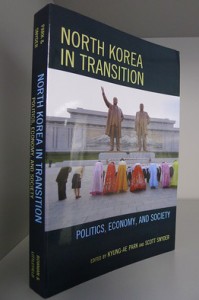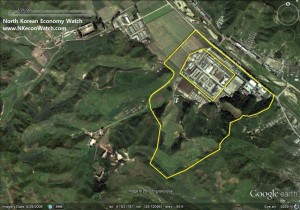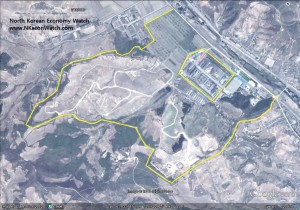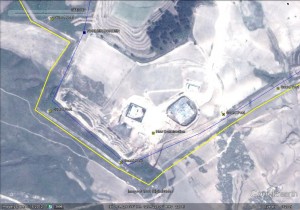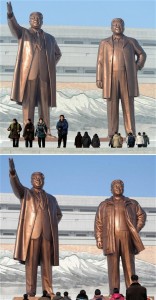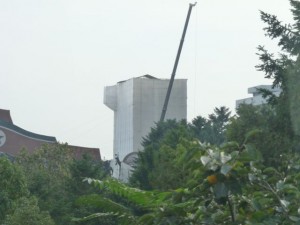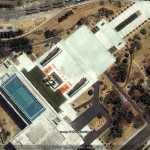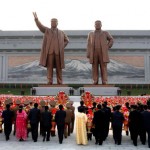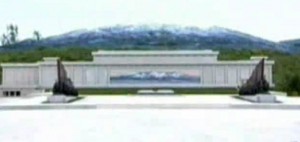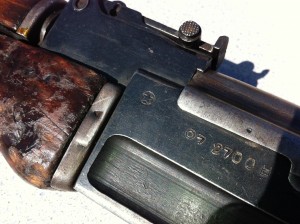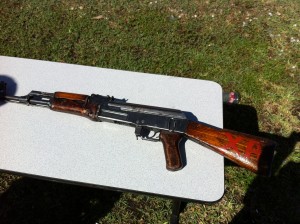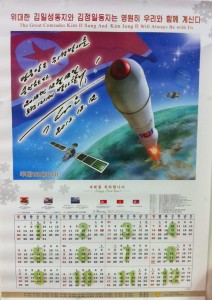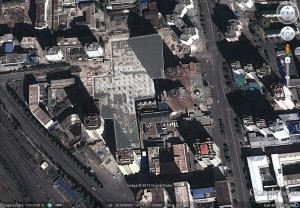UPDATE 25 (2013-3-31): The Washington Post reports on the unresolved question of whether the DPRK tested a plutonium or uranium nuclear device:
In the days following the detonation, U.S. and South Korean sensors failed to detect even a trace of the usual radioactive gases in any of the 120 monitoring stations along the border and downwind from the test site, the officials said. A Japanese aircraft recorded a brief spike of one radioactive isotope, xenon-133, but it was seen as inconclusive, the analysts said. Xenon-133 is released during nuclear weapons tests but also given off by nuclear power plants.
…
The second analyst familiar with the data said it appeared that North Korea “went to some length to try to contain releases. One possible reason to try to contain releases is secrecy, so we don’t know very much about their nuclear testing.”
The second analyst added that North Korea also appears to be worried about the reaction from China, its most important ally, in the event that radioactivity drifts across the border and causes panic among residents.
Officials and analysts said North Korea’s second nuclear test, which occurred in 2009, also left no detectable traces. Some experts pointed out that finding evidence of a nuclear blast is often a matter of luck because of the dependence on air currents and geological features at the test site. Still, it would not be surprising for North Korea to take extra steps to prevent outsiders from gaining insights into its nuclear capability, said a third U.S. official with access to classified data on the tests.
“Any country conducting a nuclear test works hard to contain it,” the official said.
U.S. intelligence agencies had positioned special aircraft in the region in hopes of picking up two or more types of radioactive isotopes from the blast. Comparing ratios of isotopes can help determine the material used in the device.
Seismology readings confirmed that the explosion occurred under a mountain near North Korea’s border with China. The readings indicated it was roughly as powerful as the bomb dropped on Hiroshima. Statements released by U.S. intelligence agencies have described the Feb. 12 event as a “probable” nuclear test.
North Korea’s state-run news agencies said the country had “diversified” its nuclear stockpile with the new test. The declaration underscored concerns that the North had mastered a design that uses the country’s ample supply of uranium. North Korea’s plutonium stockpile consists of only a few dozen pounds of the gray metal, enough to build a handful of bombs. But recent visits to North Korea by U.S. nuclear experts confirmed that Pyongyang operates at least one uranium-enrichment factory, described by visitors as large, sophisticated and fully operational.
UPDATE 24 (2013-3-7): UNSC passes 2094.
UPDATE 23 (2013-2-26): Jeffrey Lewis in 38 North, “Frienemies: The North’s Nuclear Test Was Bad Enough, The South Shouldn’t Make It Worse”
UPDATE 22 (2013-2-23): Yonhap reports on the treatment of those involved in the test:
More than 11,000 North Koreans have been cited for their contribution to the country’s nuclear test earlier this month, the country’s media said Saturday.
North Korea carried out its third nuclear test on Feb. 12, drawing strong international condemnation. The U.N. Security Council is currently working out countermeasures to penalize the communist country.
The North’s Korean Central News Agency (KCNA) said in a report that a total of 11,592 scientists, technicians, workers and officials have received state decorations for their roles in the test.
The report, monitored in Seoul, gave no further details, including the identify of any awardees.
The English-language report also said that “100 were awarded the title of Hero of the DPRK (North Korea) with a gold star medal and Order of National Flag First Class.”
Following its December long-range rocket launch, North Korea had earlier honored a total of 101 scientists and engineers with the Hero of the DPRK titles, according to the KCNA.
An additional 5,700 were cited for their contribution to the launch, it said.
UPDATE 21 (2013-2-19): Russia has staked out its position on the imposition of further sanctions by the UNSC. According to Reuters:
“Any additional measures of pressure on North Korea should be aimed exclusively at the sphere of non-proliferation of nuclear arms and rocket launches,” Deputy Foreign Minister Gennady Gatilov told a news conference.
“We are against measures that would affect normal trade and economic relations with North Korea. We understand our Chinese colleagues have similar views.”
UPDATE 20 (2013-2-18): The EU has passed additional sanctions on the DPRK. According to Reuters:
The sanctions expand those approved by the U.N. Security Council in January, adding measures preventing trading in North Korean government bonds, gold, precious metals, and diamonds, EU diplomats said.
“We have pushed for enhancing the sanctions. This is the answer to a nuclear programme which endangers not only the region but the whole security architecture worldwide,” Germany’s Foreign Minister Guido Westerwelle said during a meeting with his EU counterparts in Brussels.
The new sanctions ban components that could be used in ballistic missiles such as “certain types of aluminum used in ballistic missile-related systems”.
North Korea was widely condemned last week after its third nuclear test since 2006, defying United Nations resolutions and putting the country closer to a workable long-range nuclear missile.
North Korean banks will also barred from opening new branches in the European Union and European banks would not be able to open new branches in the northeast Asian state. Diplomats could not say if North Korean banks had any branches in the EU.
According to US News:
The 27 EU finance ministers also demanded North Korea abstain from further tests and urged it to sign the Comprehensive Nuclear Test Ban Treaty without delay. The statement came as the ministers met Monday in Brussels.
Their action brings the number of North Koreans subject to a travel ban and an asset freeze to 26, and the number of sanctioned companies to 33. The ministers also banned the export of components for ballistic missiles, such as certain types of aluminum, and prohibited trade in new public bonds from North Korea.
For more detailed information on the EU sanctions see here:
Council conclusions on the Democratic People’s Republic of Korea (DPRK), 3222nd Foreign Affairs Council meeting, Brussels, 18 February 2013 (PDF)
Council reinforces EU sanctions against �orth Korea, Brussels, 18 February 2013, 6330/13, PRESSE 53 (PDF)
UPDATE 19 (2013-2-16): Today a couple of articles came out on the Chinese perspective. Chinese tired of North Korea’s behavior. Chinese worried about radiation.
UPDATE 18 (2013-2-15): The US House passes a resolution condemning the blast. On February 25, the US Senate passed a resolution.
UPDATE 16 (2013-2-15): Jeffrey Lewis on yield estimates.
UPDATE 15 (2013-4-15): Friday Fun from Andy Borowitz!
UPDATE 14 (2013-4-15): Update on CTBTO findings related to the announced nuclear test by North Korea.
UPDATE 13 (2013-2-14): The Daily NK reports that the North Korean city of Hyesan experienced earth quake damage.
UPDATE 12 (2013-2-14): The Washington Post on sanctions.
UPDATE 11 (2013-2-14): The South Koreans report that they have been unable to detect isotopes in the air for analysis. According to the BBC:
Finding certain isotopes – xenon gases in particular – would help experts determine whether a plutonium or uranium-based device was used.
But a well-contained test could yield no radioactive isotopes, experts say.
South Korean planes and ships were sent out immediately after the test to collect samples, as was a Japanese plane.
“Two days since the North’s nuclear test, the commission has completed analysing eight samples, but no radioactive isotopes have been discovered as of 15:00 Thursday,” the commission said.
No changes had been recorded at 122 unmanned radiation monitoring systems across the country, it added.
The story also reports on South Korean responses to the test.
The Economist also offers a roundup of the international relations.
UPDATE 10 (2013-2-13): Writing in 38 North, David Albright explores the technical advances made in the DPRK’s nuclear program. Here is the conclusion:
Regardless of North Korea’s progress prior to the February 12, 2013, test in miniaturizing its nuclear warheads, this underground nuclear test has likely advanced North Korea’s nuclear weapons program. North Korea could have improved the reliability of its designs and learned to further miniaturize its warheads for ballistic missile delivery. One important outstanding question is whether the test involved only plutonium or highly enriched uranium alone or in combination with plutonium.
ISIS assesses that North Korea has the capability to mount a warhead on the Nodong missile, although it recognizes the uncertainty in this estimate and that the warhead’s reliability cannot be ascertained. The test on February 12 could have, as North Korea stated, demonstrated this capability.
North Korea probably cannot deploy a warhead on an ICBM. However, with additional effort and time, North Korea will likely succeed in developing such a warhead too. More broadly, additional underground nuclear tests are bound to help North Korea produce a more sophisticated nuclear weapons arsenal that is both more deliverable and more deadly.
UPDATE 9 (2013-2-13): The Choson Ilbo on the cost of the DPRK’s nuclear program.
UPDATE 8 (2013-2-13): On the China – DPRK relationship
The Washington Post: Why China still supports North Korea, in six little words.
The New York Times publishes an article on the China – DPRK relationship.
Reuters published an article on the China – DPRK relationship citing different sets of data. Here are a couple of blurbs:
“The more the United States rebalances its forces in the Western Pacific, the more China has to give leeway in regulating its relationship with North Korea,” said Shen Dingli, a regional security expert at Shanghai’s Fudan University.
And North Korea is exploiting the current high levels of Sino-American mistrust.
and…
“China has always been worried that North Korea could collapse quickly,” said Zhu Feng, a professor of international studies at Peking University.
“It could be a refugee issue, or civil unrest, or military confrontations. That is why China has been hesitating,” he said.
In addition to providing undisclosed amounts of food and fuel to keep North Korea afloat since a mid-1990s famine killed more than a million North Koreans, Beijing has stepped up trade and investment.
China-North Korea trade rose an annual 24.7 percent to $3.1 billion in the first half of 2012, while the 2011 figure of $5.7 billion was a 62.4 percent gain over 2010. Beijing is also thought to take a generous – to Pyongyang – view of what constitutes “luxury goods” under a U.N. sanctions resolution banning exports of such items to North Korea.
UPDATE 7 (2013-2-12): Scott Snyder offers a summary of the event. Here is Jeffrey Lewis’ take on the explosion. Kim Jong-un gets photo with personnel.
UPDATE 6 (2013-2-12): Plutonium or uranium discussion begins.
The New York Times: North Korea’s Lesson: Nukes for Sale
Associate Press: NKorean Nuclear Test May Be Intelligence Windfall
UPDATE 5 (2013-2-12): The UNSC condemned the test. According to Reuters:
The non-binding statement was approved by all 15 council members.
U.S. Ambassador to the United Nations Susan Rice said that Washington and its allies want the Security Council to pass a resolution that would “augment the sanctions regime” already in place due to Pyongyang’s 2006 and 2009 atomic tests.
The council statement was agreed at an emergency closed-door session convened by South Korea. Diplomats say negotiations on new sanctions could take weeks since China is likely to resist tough new measures for fear that new sanctions could lead to further retaliation by the North Korean leadership.
The UNSC statement can be found here.
A good summary of the situation on NPR.
Here is more in the Guardian.
UPDATE 4 (2013-3-12): And for some humor: The Onion headline, “World Surrenders To North Korea“. We should take bets as to which state-owned media source will pick this up as factual.
UPDATE 3 (2013-2-12): Institute for Science and International Security statement. Aidan Foster-Carter in the BBC.
US looks for leverage.
UPDATE 2 (2013-2-12): Well, it is the morning of the 12th on the east coast of the US. Here are some of the news outlets reporting this am: Wall Street Journal, Washington Post, New York Times, ABC (USA).
China, US, Japan condemn.
China, DPRK relations.
US Treasury Bonds unchanged.
Kaesong Industrial Zone unaffected.
38 North has lots of satellite imagery analysis.
Rodong Sinmun issued this statement.
KCNA has also published the following:
KCNA Report on Successful 3rd Underground Nuclear Test
Pyongyang, February 12 (KCNA) — The Korean Central News Agency released the following report on Tuesday:
The scientific field for national defence of the DPRK succeeded in the third underground nuclear test at the site for underground nuclear test in the northern part of the DPRK on Tuesday.
The test was carried out as part of practical measures of counteraction to defend the country’s security and sovereignty in the face of the ferocious hostile act of the U.S. which wantonly violated the DPRK’s legitimate right to launch satellite for peaceful purposes.
The test was conducted in a safe and perfect way on a high level with the use of a smaller and light A-bomb unlike the previous ones, yet with great explosive power. It was confirmed that the test did not give any adverse effect to the surrounding ecological environment.
The specific features of the function and explosive power of the A-bomb and all other measurements fully tallied with the values of the design, physically demonstrating the good performance of the DPRK’s nuclear deterrence that has become diversified.
The nuclear test will greatly encourage the army and people of the DPRK in their efforts to build a thriving nation with the same spirit and mettle as displayed in conquering space, and offer an important occasion in ensuring peace and stability in the Korean Peninsula and the region.
And this…
Spokesman for DPRK Foreign Ministry Urges U.S. to Choose between Two Options
Pyongyang, February 12 (KCNA) — The DPRK Foreign Ministry released the following statement on Tuesday:
The DPRK’s third nuclear test is a resolute step for self-defence taken by it to cope with the U.S. hostile act against it.
Its successful launch of satellite Kwangmyongsong 3-2 in December last year was a peaceful one from A to Z which was conducted according to its plan for scientific and technological development for economic construction and the improvement of the standard of people’s living.
The world including hostile countries recognized its application satellite’s entry into orbit and greatly admired its development of space technology.
The U.S., however, again prodded the UN Security Council into cooking up a new “resolution on sanctions” against the DPRK, terming its satellite launch a violation of the UNSC’s “resolution”.
Encroaching upon the right to satellite launch is an unpardonable grave hostile act as it is an infringement on the DPRK’s sovereignty.
By origin, the DPRK had neither need nor plan to conduct a nuclear test.
The DPRK’s nuclear deterrence has already acquired the trustworthy capability strong enough to make a precision strike at bases for aggression and blow them up at a single blow no matter where they are on the earth.
It was the DPRK’s goal to focus efforts on economic construction and the improvement of the standard of people’s living by dint of nuclear deterrence for self-defence provided by the great Generalissimos Kim Il Sung and Kim Jong Il all their lives.
The DPRK exercised its maximum self-restraint when the U.S. fabricated the “presidential statement” over its satellite launch for peaceful purposes by abusing the UNSC in April last year.
But the DPRK’s patience reached its limit as the U.S. intensified such hostile act as implementing before anyone else the UNSC’s “resolution on sanctions”, far from apologizing for its renewed wanton violation of the DPRK’s right to satellite launch.
The main objective of the current nuclear test is to express the surging resentment of the army and people of the DPRK at the U.S. brigandish hostile act and demonstrate the will and capability of Songun Korea to defend the sovereignty of the country to the last.
The DPRK’s nuclear test is a just step for self-defence not contradictory to any international law.
The U.S. has long put the DPRK on the list of preemptive nuclear strike.
It is quite natural just measure for self-defence to react to the U.S. ever-increasing nuclear threat with nuclear deterrence.
The DPRK withdrew from the NPT after going through legitimate procedures and chose the way of having access to nuclear deterrence for self-defence to protect the supreme interests of the country.
There have been on the earth more than 2 000 nuclear tests and at least 9 000 satellite launches in the UN history spanning over 60 years but there has never been a UNSC resolution on banning any nuclear test or satellite launch.
It is the U.S. that has conducted more nuclear tests and launched more satellites than any others. It, however, cooked up the UNSC’s “resolution” banning only the DPRK’s nuclear test and satellite launch. This is the breach of international law and the height of double standards.
Had the UNSC been impartial even a bit, it would not have taken issue with a sovereign state’s exercise of the right to self-defence and its scientific and technological activities for peaceful purposes but with the U.S. policy for preemptive nuclear strike, a threat to global peace and security, to begin with.
The current nuclear test is the primary countermeasure taken by the DPRK in which it exercised its maximum self-restraint.
If the U.S. takes a hostile approach toward the DPRK to the last, rendering the situation complicated, it will be left with no option but to take the second and third stronger steps in succession.
The inspection of ships and maritime blockade touted by the hostile forces will be regarded as war actions and will invite the DPRK’s merciless retaliatory strikes at their strongholds.
The U.S., though belatedly, should choose between the two options: To respect the DPRK’s right to satellite launch and open a phase of detente and stability or to keep to its wrong road leading to the explosive situation by persistently pursuing its hostile policy toward the DPRK.
In case the U.S. chooses the road of conflict finally, the world will clearly see the army and people of the DPRK defend its dignity and sovereignty to the end through a do-or-die battle between justice and injustice, greet a great revolutionary event for national reunification and win a final victory.
UPDATE 1 (2013-2-11): English reports coming out. CNN, Wall Street Journal, Guardian, Donga Ilbo, Yonahp, Washington Post, New York Times
ORIGINAL POST (2013-2-11): The South Korean media is reporting an “earthquake” in the DPRK. This is suspected to be the third nuclear test. There is not much on this yet, but here are some links:
Yonhap
Choson Ilbo
USGS earthquake data
Daily NK
38 North published this piece a couple of days ago
Nothing on KCNA or Rodong Sinmun yet.
I am told the following:
They’re not 100% sure but they are saying “what else could cause the artificial earthquake?”
Lee Myung bak called emergency National Security Council meeting and escalated their military readiness posture from 3rd degree to 2nd degree.
Some news outlets are saying the NK government told the US and China yesterday that they are going to test.
On February 3, 2013, ISIS reported on the status of the DPRK’s nuclear test site.

